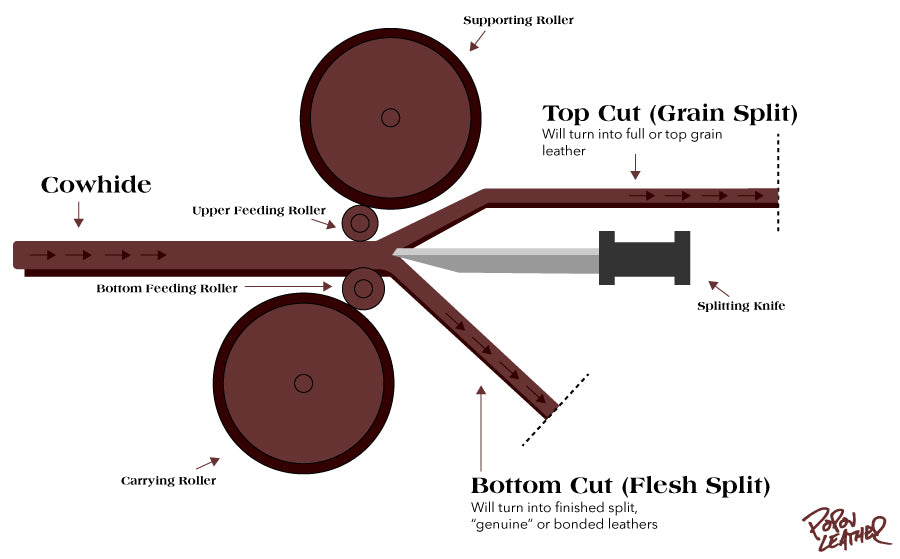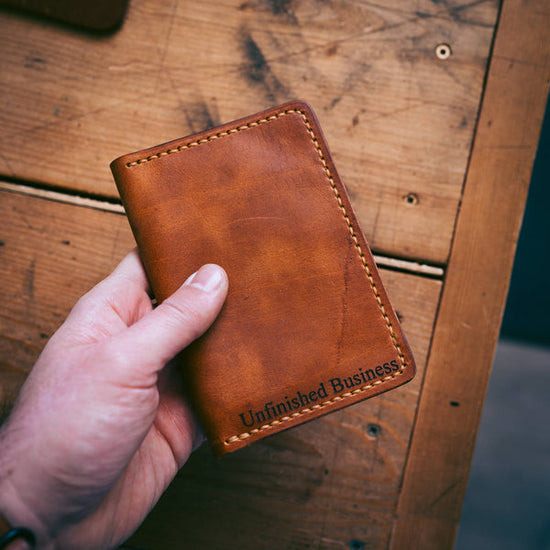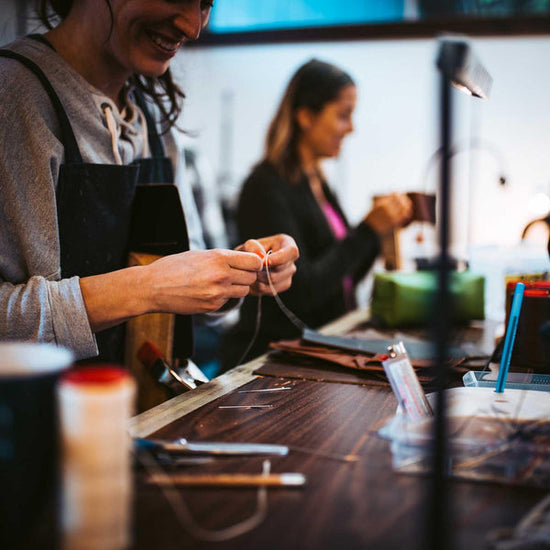Is “Genuine” leather genuine? What’s the difference between Top and Full Grain leather? Before you buy your next wallet or couch, let’s dispel some common myths and dive into what these leather grades mean.
There’s a lot of information and a lot of misinformation about the various types of leather.
As someone who has worked with leather professionally for over 6 years and made thousands of wallets, even I was confused conducting this research.
Many websites have conflicting information which made this process difficult.
My hope is that consumers who take the time to inform themselves with this guide can make better purchasing decisions.
Table of Contents
It Starts with a cowhide
The Grades of Leather
Top Grain Leather – Simple is Best
Corrected Grain Leather – Good as full grain?
Split Grain Leather – The Leather Leftovers
Bonded Leather – Scraps and Slurry
Comparing Leather: A Wood Analogy
Which Leather is right for you?
It Starts with a Cowhide
All cowhides (also called rawhide) range in thickness between 6 and 10mm. This thickness isn’t usable for much -especially not wallets or book covers.
So it’s split into usable sections. Here’s an example of how a cowhide passes through a splitter and is made into top and bottom cuts.

When we order our leather from Horween, we specify the thickness that we want. The leather thickness we use for most of our goods is between 1.2 and 1.6mm.
Before tanning and processing, the tannery takes each cowhide and “splits” it. Hides need to be split in the wet stage to achieve the final leather weight. If the leather isn’t split and shaved, the weights (thickness) would be uneven through the full side of the processed leather and the chemicals, dyes, and/or waxes would not penetrate into the leather properly during the retan/color/fat liquoring stage.
They take the hide and shear off the top cut for us. This portion contains the full grain of the hide and that’s what we make our products out of.
The bottom cut is used for lower grades of leather which I’ll discuss later below.
The Grades of Leather
There is no official standard for grading leather. Most tanneries use their own proprietary systems of grading based on cosmetic imperfections – not quality.
For example, Wickett & Craig use the following grades: standard, utility, and special to describe the number of blemishes and marks on their hides.
However, there are 3 common categories in which we can classify leather-based on how a hide is finished and which section of the cowhide is used.
These leather categories are used interchangeably throughout the industry by manufacturers and retailers alike.
The leather grades are as follows (listed in order of quality):
- Top Grain Leather, which includes:
- Full Grain Leather
- Corrected Grain Leather
- Split Grain Leather (sometimes called “Genuine Leather”)
- Bonded Leather
Take a look at this cross-section of a cowhide. You can see where each leather grade comes from when the cowhide is split.
Noticeably absent in this diagram is Bonded Leather – an abhorrent concoction of leather slurry I will cover later.

Top Grain Leather – Simple is Best
“Top grain can be either a full-grain leather or corrected grain leather.”

Full Grain Leather
In simplest terms, if you’re looking for heirloom quality leather grades you want to start with top-grain leather which includes Full Grain and Corrected Grain leathers.
Full Grain Leather at a Glance
Common Uses:
Full-grain leather is often used in goods and products where customers seek a higher-end experience. People who really want to put their own mark on the product through patina and everyday use.
Characteristics of Full Grain Leather:
- Marbling or fat wrinkles that look like shaded bands
- Variations in the grain and coloring
- Scars and “imperfections”
- Pigments and dyes will often be in varying shades across the leather
- In some leathers hair follicles are present and can be seen.
What is Full Grain Leather?
Full-grain is a side of leather with the complete grain intact. The surface hasn’t been altered except (in almost all cases) the hair has been removed.
This leather can include natural markings such as scarring, blemishes, insect bites, branding, and stretch marks. But these markings are considered the signature of fine leather goods.
A common misconception is that these types of markings are “defects.” Instead, think of these as proof of natural origin. These markings incorporate the life of the animal. The absence of natural markings often means that the leather is of lesser quality.
Another feature of full grain leather is that it breathes.
The leather will absorb moisture and oils from handling it over time. And this leather will patina beautifully.
Full-grain leather is also very durable.
Since the grain is fully intact, its fibers contribute to its strength. It’s not uncommon for a leather wallet to outlast the threads used to stitch it together!
Types of Full Grain Leather
Horween Derby or Dublin Leathers
This is another beautiful leather that is tumbled to produced rich character and textures within the grain. It features a subtle pull-up and ages wonderfully.
Vegetable Tan Leather (can also be called tooling leather)
You’ve probably seen this type of leather. It’s notoriously hard to work with because it doesn’t have a protective finish. It patinas like CRAZY often turning dark brown after a short period. It absorbs everything in its environment.
Corrected Grain Leather – Good as full grain?

Next on my list is Corrected Grain leather.
Corrected Grain is a contentious issue with leather workers and fans of leather goods alike because many people consider this to be inferior to full grain. The truth is, Corrected Grain and Full Grain both come from the same part of the cowhide.
Top Grain Leather at a Glance
Common Uses:
Very common with accessories, upholstery and footwear categories. Nubuck is often used for boots and higher-end work gloves. Smooth corrected grains are often seen used with formal footwear.
Characteristics of Top Grain Leathers:
- Marbling or fat wrinkles are diminished as sanding and pigmentation conceals these properties
- Variations in the grain and coloring disappear
- Scars and “imperfections” are sometimes sanded away
- Often uniform in color, no variation or depth of color (some exceptions for example Chromexcel has wonderful pullup effects)
- Leather is resistant to stains/spills
- Less breathability
- Somewhat waxy feel
What is Corrected Grain Leather?
People can confuse the “top grain” and “full-grain” leather grades as different splits of leather, but according to John Culliton from Horween: “top grain can be either a full-grain leather or corrected grain leather.”
It simply means that this leather is from the top cut of the hide when it is split. This is the same section where full-grain is split.
So how is Corrected Grain leather different than Full Grain leather?
In a nutshell, tanneries will remove “imperfections” or add varying degrees of corrections to achieve a desired look or functionality.
Many big manufacturers (especially in apparel and footwear) cannot have cosmetic variances in their products – therefore they choose top grain leathers for quality, but also to have a consistent appearance in their leather goods.
Two examples are Horween’s Snuffed Suede leather and Chromexcel.
Snuffed Suede leather is heavily corrected to create a Nu-Buk effect (heavy tracking) whereas Chromexcel is “corrected”, through a process that is more of a burnishing operation. This allows Horween to hand-stain the leather. The burnishing operation on Chromexcel prepares the leather for finishing by opening up the grain and allowing the stains to penetrate the leather.
During this corrective process, the pores of the leather are sealed. This means the leather can be easier to clean and doesn’t absorb as many oils and moisture. It also means that patina can take a longer time to develop and there’s less breathability compared to full grain.
Some folks consider corrected grain less durable than full-grain because of the sanding during the correcting process. It’s a weak argument, and in my experience, I haven’t found any durability issues with corrected grain.
Types of Corrected Grain Leather
Horween Chromexcel Leather
Chromexcel is a trademark tanning process from the Horween Leather Company. A combination tanned leather that undergoes at least 89 separate processes taking 28 working days.
A corrected grain leather with dramatic pull-up and soft waxy feel. Even though these can be pigmented with color, they will still Patina dramatically over time.
John Culliton from Horween says “The whole world thinks Chromexcel is full grain because when you look closely at it, you can see the grain. But we correct it, we just correct it so little that we leave part of the grain on the leather.”
Smooth Corrected Grain
These types of top grain leathers are popular with formal shoes and can be buffed to an eerie and glass-like appearance.
Embossed Corrected Grain
Usually an imitation print is stamped over top using a plating press using high heat and pressure. Some top grains have leather grain texture printed on top after it’s been sanded away.
Other types of embossing include pebble, hair cell, exotic and man-made.
If you’ve seen alligator or snake leather, it’s usually top grain leather with an embossed print.
Nubuck
These top grain leathers are sanded and buffed to a matte finish. The have a fuzzy feel – like suede but not as “hairy.”
These leathers hide scratches well and are less prone to cracking when repeatedly exposed to the elements. A lot of shoe and boot manufacturers favor nubuck for it’s durability and appearance.
Split Grain Leather – the Leather Leftovers


The next category of leather goods in our grading scale is split-grain leather. This is where it’s common to see durability and quality issues.
Split Grain Leather at a Glance
Common Uses:
Almost all leather goods you’d see in a big box store are made from finished split leather (aka genuine leather). Check for the stamp that says so.
Characteristics of Split Grain Leather:
- Marbling or fat wrinkles, variations, scars, and “imperfections are removed during the corrective process.
- Pigments and dyes will often be a uniform color,
- No variation or depth of color
- Leather is resistant to stains/spills
- Zero breathability
- Plastic feel
- Not durable

What is Split Grain Leather?
You know that part of the leather that gets shaved or split off at the bottom? That’s considered split grain.
It sometimes has a nappy appearance and doesn’t contain any of the hide’s grain. It’s created from the fibrous part of the hide that’s left over.
Split grains are the leftovers.
Split grain leather doesn’t have any of the hide’s natural markings and products made from this material won’t stand the test of time.
Finished split leather is often coated with polymer and embossed to make it look like natural leather. Then it’s stamped with the words “Genuine Leather” to fool you into thinking its good quality.
Types of Split Leather
Genuine Leather (also called Bicast)
Finished split leather is often referred to as “Genuine” leather simply because it’s a marketing person’s strategy designed to fool customers. When you see the word “Genuine” you think of quality and the “real deal.”
Unfortunately, this is total garbage.
Genuine leather is often several layers of split leather bonded together with a thin polyurethane or vinyl layer to give it strength and a uniform appearance. The backing is generally not visible to the end consumer.
These are heavily processed off-cuts, that are the least breathable and will never develop a patina. Unless you count surface-cracking and falling apart patina.
And the feel is almost always like plastic.
And the smell?
Ever walk into a crappy shoe store and get hit by that trademark fake leather scent? That’s how you know you’re surrounded by genuine leather.
Suede
Suede is well known for its signature textured feel and “napped” look. Often made from lamb, goat, deer, or calfskins. Suede is less durable, thin, and absorbs liquid very easily.
Bonded Leather – Scraps and Slurry


Welcome to the last stop on our tour of the leather grades. The absolute rock-bottom of the leather grades.
Bonded Leather at a Glance
Common Uses:
Cheaply made bags, office supplies, books, and upholstery on furniture.
Characteristics of Bonded Leather:
- Made from a combination of PVC, fiber content, and as little as 20% leather
- Grain and appearance will be uniform since it’s artificially embossed and spray painted
- Will not breath
- Feels like plastic
- Smells artificial
- Will never patina
- Will de-laminate and fall apart in a short time

What is Bonded Leather?
This is simply the lowest leather grade available. It’s the hot dog of leathers. Essentially leather dust is mixed with vinyl and turned into a sheet.
Shreds of leather from leftover scrap are mulched and mixed into a pulp slurry, then spread on a fiber cloth or paper backing with a polyurethane adhesive.
This finished sheet is then spray painted and/or embossed with a print.
In some countries where bonded leather is manufactured, this type of “leather” is made with as little as 20% actual leather fibers.
Bonded leather could be considered more environmentally friendly since it uses recycled bits of leather that would otherwise be disposed of.
But then you have to think of all the crappy wallets and belts being thrown away due to quality.
Comparing Leather Grades: A Wood Analogy
Full Grain Leather
If full-grain leather was compared to a type of wood, it would be a walnut table with a live edge.
This slab of wood is prized for its living edge which shows the story of the tree it came from. Each table is one of a kind and many “imperfections” remain in place.

Corrected Grain Leather
If corrected grain leather was compared to a type of wood, it would be a solid and durable, but mass-produced oak dining room table. Well-constructed and consistent.
It can be lightly corrected or heavily sanded, buffed, and varnished wood that is well-suited for commercial purposes.

Split Grain Leather
If split-grain leather was compared to a type of wood, it would be similar to composite or engineered wood.
Not a true piece of wood but something built from multiple layers of thin wood that wouldn’t otherwise be used. Quality can vary widely, engineered wood is not as durable as solid wood. It can become chipped or de-laminated.

Bonded Leather
If bonded leather was compared to a type of wood, it would be cheap particle board.
Particle board is not real wood but made up of wood chips and sawdust. Bonded Leather is not real leather.

Which Leather is right for you?
If you were paying attention, there are two leather grades that are undoubtedly the best quality: Full and Corrected grain.
These grades of leather are both sheared from the same durable grain and will patina over time. Imperfections and personality that come from full-grain is a personal preference, but I would have it no other way.
I love celebrating the personality that comes from each cowhide and the dramatic patina that every customer makes using their Junyuan Bags goods.
Do you have a story about your experiences with genuine or bonded leather? Was there a time you bought something full-grain and it has developed crazy character? Share below! ?

Engraved Wallets for Men: 6 Ways to Personalize a Leather Wallet

Hand Sewn VS Machine Sewn Leather Goods
Junyuan Bags | Professional Bag Manufacturer
Ten articles before and after
Cable Management Ideas To Keep Your Cords In Line – Junyuan Bags
How To Clean a Phone Case: 3 Tips Everyone Can Use – Junyuan Bags
Sewing Leather Goods by Hand or by Sewing Machine? Which is better? – Junyuan Bags
Why Do Headphones Get Tangled and How To Untangle Them – Junyuan Bags
A DIY Leather Baseball Pattern: Make Your Own – Junyuan Bags
What Is Genuine Leather? The Truth About Genuine Leather and Is It Rea – Junyuan Bags
Engraved Wallets for Men: 6 Ways to Personalize a Leather Wallet – Junyuan Bags
RFID Blocking: How It Works and Why It's Important – Junyuan Bags
Picking EDC Knives: What To Look For in an Everyday Carry Knife – Junyuan Bags




 Mobile/What's App/Wechat
Mobile/What's App/Wechat E-Mail
E-Mail ADD
ADD




